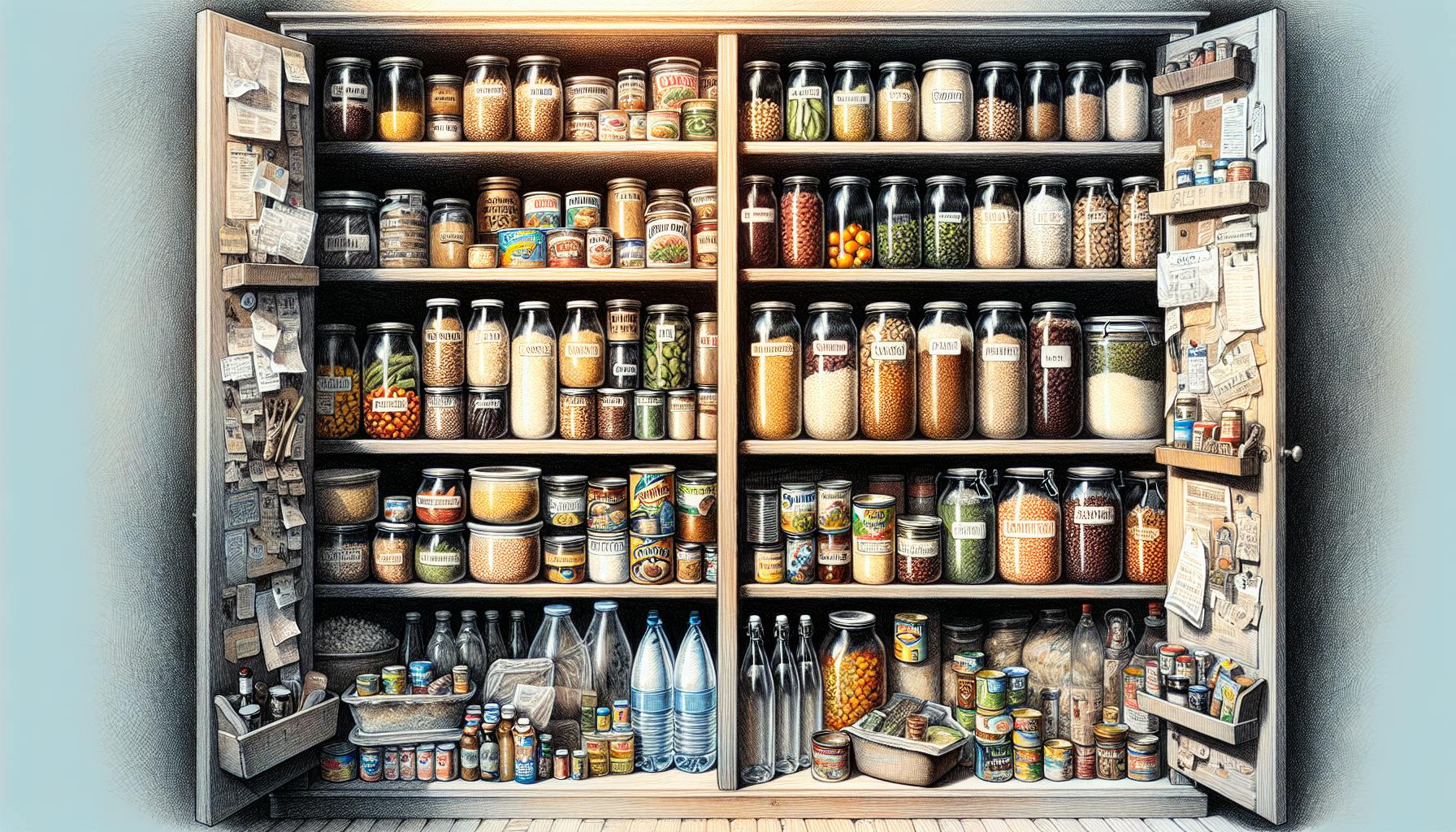Introduction to the Importance of Canned Goods for Survival Preparedness
Having the right selection of canned goods is an essential component of any emergency preparedness plan. Canned foods provide the ideal balance of long shelf life, portability, and nutritional content when planning for disasters or SHTF scenarios. With shelf lives of 2-5 years for most canned goods, they offer long-term viability that's perfect for survival stockpiling. And thanks to their condensed, sealed packaging, canned goods are highly portable for bug out bags, evacuation supplies, and off-the-grid living. Canned fruits, vegetables, proteins, meals, and staples are all important additions when building well-rounded food reserves. This comprehensive guide from prepping experts WeLovePrepping will explore recommended canned goods for survival kits, proper storage methods, choosing situation-specific cans, smart stockpiling strategies, and other vital guidance to get your canned goods preps in order. Let's review why canned goods are a prepper's best friend and how to leverage them for your survival plan!
Why Canned Goods Are Ideal for Emergency Preparedness
From hurricanes to civil unrest, having an ample supply of survival food is a cornerstone of emergency preparedness. Canned goods offer distinct advantages over other food types when it comes to disaster readiness:
-
Ultra-long shelf life - Most canned goods last 2-5 years when stored properly. Even canned meats/fish keep for 2-3 years typically. You can stockpile cans for the long haul.
-
Portability - The condensed size and durable packaging of cans makes them highly portable for evacuations and supply transport.
-
Nutritionally balanced - Fruits, vegetables, proteins, and meals provide balanced nutrition in an emergency.
-
Requires no refrigeration - Canned goods store safely at room temperature away from light and moisture.
-
Convenient & fast access - Pop-top and pull-tab cans allow quick access without tools.
-
Versatile ingredients - Canned staples help you prepare diverse meals and baked goods from your pantry.
When building your emergency food reserves, be sure to take full advantage of canned goods and their distinct survival advantages. Let's explore more about choosing and storing cans for survival preparedness...
Prioritizing Nutrition When Selecting Canned Goods
While canned goods offer convenience, you still need to make careful selections focused on nutrition to support health during extended survival situations. Seek out low-sodium, no sugar added options whenever possible to limit heavy additives.
Canned fruits packed in juice rather than sugary syrups provide vital vitamins and minerals. Canned vegetables, beans, lentils are excellent sources of fiber, vitamins, and energizing carbohydrates.
Canned meats, fish, poultry, chili and other proteins supply satisfying protein, healthy fats, and strength-sustaining calories. Just be sure to favor cans with reduced sodium to avoid excess salt intake.
With nutritious canned goods stocked in your prepper's pantry, you'll have the energy, nutrition, and fortitude to persevere through any disaster scenario.
Essential Canned Goods for Your Survival Stockpile
Building a well-rounded stockpile of canned goods is key to being fully prepared with survival food. Here are the must-have canned items to include for comprehensive nutrition and meal flexibility:
Canned Fruits and Vegetables
Fruits and veggies in cans provide much needed vitamins, minerals, fiber and variety. Peaches, pears, pineapple, mixed fruit, carrots, peas, green beans, corn and more cover all the bases. Look for canned produce with no added sugar or sodium whenever possible. WeLovePrepping offers canned fruit and vegetable medley kits ideal for preppers.
Canned Meats, Fish, Poultry and Proteins
Protein-rich options like canned tuna, salmon, chicken, turkey, ham and chili offer energy, strength and satiation. Beans, lentils and other legumes provide plant-based protein, fiber and nutrients. Prioritize low-sodium varieties packed in water over oil. WeLovePrepping stocks a full range of canned proteins for preppers.
Canned Soups, Stews and Meals
Search for lower-sodium soups and stews with wholesome ingredients when stocking up your prepper's pantry. Hearty canned chili, ravioli, and rice/pasta sides make for quick, convenient meals with minimal work. Add canned chicken or other proteins to soups and rice for extra nutrition. Browse WeLovePrepping's selection of canned meals ready for emergencies.
Canned Staples: Sauces, Condiments, Baking Items
Beyond main ingredients, don't forget canned sauces, condiments, baking items and more! Tomato sauce, coconut milk, olives, butter/oil, spices, flour, baking powder and the like enable you to prepare diverse recipes, baked goods and flavorful dishes with your other canned goods when SHTF. Peruse WeLovePrepping's wide array of canned staples for preppers.
Tips for Storing Canned Goods for Maximum Freshness
Proper storage is key to ensuring your canned goods remain viable and safe to eat for years to come:
-
Cool & dry area - Store cans in a temperature controlled area around 50-70°F. Avoid direct sunlight which can compromise cans over time.
-
Check for damage - Inspect cans for major dents, bulges, rust and other defects. Reject any compromised cans.
-
Use FIFO method - Adhere to first-in, first-out system to rotate stock and eat oldest cans first. Track with purchase dates.
-
Clean cans before opening - Wipe away dust and debris before opening cans to prevent contamination. Check safety after opening.
-
Clear storage bins - Utilize clear plastic bins, shelves and organizers so you can easily see canned good labels and dates.
With the right storage tactics, your nutritious canned goods will retain optimal quality and safety for years, keeping your food preps in order.
Choosing Canned Goods for Different Survival Scenarios
When building your canned good reserves, it's important to tailor your selections to the specific emergencies you're prepping for. Disasters can range from short-term situations like storms to long-lasting catastrophes. And emergency response options span from sheltering at home to evacuating and living off-grid. Here are some key considerations when choosing canned goods for different situations:
Canned Goods for Short-Term Emergencies
For short-duration disasters like blizzards, hurricanes or floods, focus on portable, easy access canned goods that require minimal to no preparation:
-
Pop-top and pull-tab cans - These allow quick access without tools for on-the-go nourishment.
-
Single-serve cans - Individual portions work nicely for solo situations and bug-out bags.
-
Ready-to-eat items - Fruits, proteins, meals provide instant nutrition without cooking.
-
Highly portable cans - Favor smaller, lighter cans for easier transport and mobility.
WeLovePrepping offers specialized canned good kits purpose-built for short-term disasters.
Canned Goods for Long-Term Survival
When prepping for worst-case scenarios like nuclear fallout or societal collapse, stock up on versatile staples for in-depth nutrition and meal variety:
-
Beans, lentils, rice - Dried versions have extraordinary shelf life. Canned beans and rice enable fast preparation.
-
Canned produce variety - Keep scurvy at bay with array of fruits and veggies.
-
Meals with recipes - Stew, chili and soup cans with recipes promote diet diversity.
-
Protein powered - Meat, fish, chicken and plant-based proteins sustain energy demands.
-
Can opener - Manual opener allows accessing your long-term stash over extended periods.
Check out WeLovePrepping's long-term survival canned goods kits for optimizing nutritional completeness.
Canned Goods for Bugging Out
When prepping a bug out bag for evacuation, compact, nutritionally-dense cans take priority:
-
Lightweight cans - Every ounce counts, so seek small cans and individual portions.
-
Pop-top access - Cans that open without tools are extremely convenient on the move.
-
Calorie and protein-focused - Seek out meats, fish, fruits and veggies over bulky starches.
-
Portion control - Repackage larger cans into sealed bags to save precious space while bugging out.
WeLovePrepping provides purpose-built bug out canned goods kits designed for portability and calories.
Canned Goods for Sheltering at Home
For sheltering in place at home during extended disasters, focus your canned goods strategy on family-friendly comfort foods and multi-serving cans:
-
Canned dairy - Condensed, evaporated and powdered milk allow cooking, baking and oatmeal enrichment.
-
Baking staples - Canned butter, shortening, baking powder and the like enable homemade breads and more.
-
Family-size portions - Larger cans minimize risky supply runs. Share larger servings.
-
Familiar favorites - Stock soups, meals and comfort foods for morale. Add canned chicken, tuna or chili to rice or pasta favorites.
WeLovePrepping offers a full range of canned goods for sheltering at home during disasters.
Canned Goods for Bunkers and Safe Rooms
When stocking a safe room or bunker, you'll need ample canned goods for complete, long-term nutrition:
-
1+ year supplies - Stock at least a year's supply of canned goods per person using the space.
-
Nutritional variety - Fruits, veggies, beans, lentils, meats and more provide dietary completeness.
-
Can openers - Ensure multiple manual can openers. Reuse opened cans by sealing with new lids.
-
Meal variety - Stew, chili and soup cans with recipes help prevent flavor fatigue.
-
Shelf life tracking - Use a log to track expiration dates of cans as you consume the stockpile.
WeLovePrepping provides key guidance on ideal canned goods for fully stocked bunkers and safe rooms.
Stockpiling Canned Goods - Key Planning Tips
Building a sufficient stockpile of survival canned goods requires careful planning and consideration:
Estimate Needed Quantities
-
Take a full inventory of current canned goods and estimate days' supply on hand.
-
Determine the daily calories per person needed in a survival scenario (generally 2000-2500).
-
Set a goal for the duration you want your canned goods supply to last (1 month, 90 days, 1 year etc).
-
Do the math to calculate approximately how many more canned goods are required to meet your preparedness goal.
Focus on Balanced Nutrition
-
Include a variety of fruits, vegetables, proteins, beans/legumes, and meals for a well-rounded nutritional foundation.
-
Incorporate comfort foods and familiar meal options to boost morale.
-
Compare brands and labels to optimize for lower sodium, higher protein, healthier ingredient options.
Monitor Expiration Dates
-
Always write purchase dates on canned goods with a marker to track age.
-
Follow FIFO principles and consume oldest cans first.
-
Take periodic inventory and replace stock that is close to expiration or recently consumed.
Shop Smart to Save
-
Buy extra canned goods when they are on sale and discount offers arise. Look for bulk case discounts.
-
Compare cost per ounce/serving between brands and sizes to identify better value picks.
-
Stick to more affordable essentials rather than pricier specialty items. Store brands can offer big savings.
WeLovePrepping provides regular deals and discounts to help prepper's stock up on canned goods affordably.
Additional Tips for Integrating Canned Goods into Your Preparedness Plans
Here are some final pointers for making the most of your canned good stockpile when planning for survival:
-
Familiarize yourself with the manual can opener and practice opening cans safely. Identify any stubborn cans in advance.
-
Consider adding a portable camping or rocket stove to your bug out gear for heating up canned soups, chili and meals off-grid if evacuated.
-
Portion out and repackage larger canned goods into sealed bags or containers to optimize portability and reduce waste when rationing.
-
Research cooking canned goods over a fire or campfire for additional meal prep options in extended disaster scenarios.
-
Inspect each can carefully before consuming, never eat from damaged or bulging cans which could contain botulism and other toxins.
-
If utilizing canned goods now with higher sodium content, gradually transition your diet to lower sodium versions to adapt your palate over time.
-
Combine canned ingredients like chicken, tuna or vegetables into dehydrated or freeze dried meals to boost nutrition and texture.
-
Use canned fruits and condensed milks to enrich oatmeal, breakfast shakes, dehydrated eggs and more.
Equipped with ample canned goods, tailored preparations and proper planning, you'll be ready to face any disaster situation with confidence. WeLovePrepping has all the tips and resources to get your canned goods preps in order. Stay prepared with WeLovePrepping!


